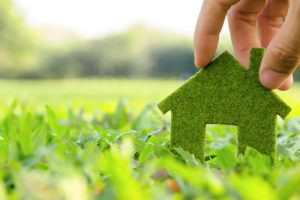Vinyl Siding, Insulated Vinyl Siding and Polypropylene Siding Match Up Nicely with Green Rating Systems That Are Becoming More Relevant to Sustainability

Because the Vinyl Siding Institute (VSI) has taken proactive measures to establish a sustainable future for their members’ products, the industry is well-positioned to qualify for points in green rating systems.
Green building certification programs have been well-established at the national, state and local levels for many years.
Recently, the United States Green Building Council (USGBC), the National Association of Home Builders (NAHB) and other organizations have been working to implement programs at the national level. This includes the USBGC’s LEED® for New Construction and LEED® for Home Rating Systems, the NAHB’s National Green Building Standard™, the Green Globes and the International Code Council’s International Green Construction Code (IgCC). There are also regional green rating systems that have become more prominent, like CalGreen (California Green Building Code).
The great news for the polymeric cladding industry is that many of the requirements for these green rating systems are based on facts and science, which recognize products’ attributes and manufacturing processes.
Here is a highlight of how polymeric cladding can receive credit and recognition under these programs:
- Environmentally preferable products. Few exteriors on the market are more environmentally preferable than vinyl siding, insulated vinyl siding and polypropylene, which have virtually no manufacturing waste, emit significantly lower toxins than other claddings’ manufacturing processes and are made with abundant and potentially recycled materials. Vinyl resin is also made from salt and ethylene gas, two natural products produced domestically.
- Diversion and waste prevention. Polymeric cladding is invaluable for helping builders develop waste prevention plans with its superior design and installation qualities, longer shelf life and complete recyclable benefits. And polymeric claddings’ re-grinding processes make landfill diversion a no-brainer, especially since the scrap and off-spec materials can be returned immediately to the manufacturing process.
- Supply chain circularity – New Pilot Credit LEED BD+C: New Construction. One could argue that the vinyl siding industry is a model for the circular supply chain, starting with its co-extrusion process, high performance and superior energy efficiencies, and its significant progress in post-consumer recycling during the past decade.
- Zero-waste manufacturing. No other cladding can make the claim of meeting this standard like the vinyl siding industry can. Vinyl siding manufacturing is an extremely efficient process thanks to co-extrusion and re-grinding.
- Product life cycle. These qualifications speak to third-party verification. Vinyl siding is the only cladding with both third-party product certification, regulated by an accredited, independent quality control agency, as well as a certified installer program.
- Resource efficiency, prefinished materials and choice of products. Most polymeric cladding does not require painting or other finishing and has a replicated wood look that is an attractive option for home builders. Polymeric claddings have a long service life compared to the competition, lasting at least 50 years.
- Environmental Product Declaration and multi-attribute optimization. This standard c. Polymeric claddings have UL Environment Environmental Product Declarations, which is now a major factor for helping builders/architects/developers gain points under all programs. These products are among just a few to publish these declarations designed to promote product transparency and accountability.
- Prescriptive Energy Option. Unique to the IgCC, insulated vinyl siding products meet ANSI/ASHRAE/IES Standard 90.1-2010 based on the percentage of energy saved above the baseline.
Greener Days Ahead
Thanks to a myriad of sustainable benefits, including durability and low maintenance, many polymeric claddings will qualify for points with most green building programs, especially the LEED for New Construction and the LEED for Homes Rating Systems, as well as the National Green Building Standard.
With VSI’s proactive approach to participating in code development and working closely with respective governing bodies – coupled with the industry’s ongoing commitment to improving the sustainability of their products and processes – expect to see more opportunities to match polymeric siding with green building projects.
______________________________________________________________________________________________________________
Don Browne is a writer, entrepreneur and local legislator who believes that the power of words can change the world. He provides unique writing services for clients in the construction, health care, IT and hospitality sectors. He has a passion for small business and start-ups, as well as writing about Irish history, family and corporate biographies. As a homeowner and father of four who is passionate about community development, Don looks forward to writing more about the exciting possibilities of creating traditional neighborhoods and more sustainable communities using modern materials.
